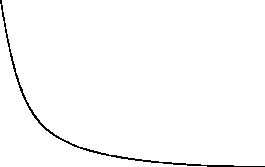TYPES OF DC MOTORS
DC Motors
Series-Wound Motor
Figure 9 Torque-vs-Speed for a Series-Wound Motor
Since the armature and field in a
series-wound motor are connected
in series, the armature and field
currents become identical, and the
torque can be expressed as shown
in Equation (6-8).
(6-8)
T
KI2a
The torque-vs-speed characteristics
of a series-wound motor with a
constant voltage source are shown
in Figure 9.
As the speed
decreases, the torque for a series-
wound motor increases sharply. As load is removed from a series motor, the speed will increase
sharply. For these reasons, series-wound motors must have a load connected to prevent damage
from high speed conditions.
Series-Wound Motor Applications
The advantage of a series-wound motor is that it develops a large torque and can be operated at
low speed. It is a motor that is well-suited for starting heavy loads; it is often used for industrial
cranes and winches where very heavy loads must be moved slowly and lighter loads moved more
rapidly.
Compounded Motor
The compounded motor is desirable for a variety of applications because it combines the
characteristics of a series-wound motor and a shunt-wound motor. The compounded motor has
a greater torque than a shunt motor due to the series field; however, it has a fairly constant speed
due to the shunt field winding. Loads such as presses, shears, and reciprocating machines are
often driven by compounded motors.
ES-06
Page 10
Rev. 0


